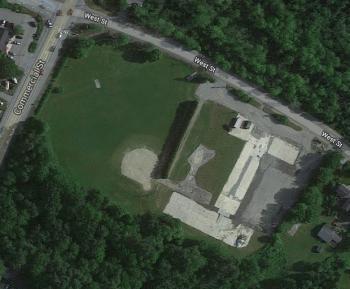Group considers selling, ‘gifting’ former Rockport Elementary School parcel to developers
ROCKPORT — A group of town officials and employees met July 17 to prepare a draft of a request for qualifications (RFQ) which will be sent to potential developers interested in building a mixed use development on a parcel of town-owned land where the Rockport Elementary School once stood. The group expects to submit a finalized RFQ to the Rockport Select Board for approval on Aug. 12.
Referred to as the RES (Rockport Elementary School) Working Group, members present at the Wednesday meeting were Select Board members Doug Cole and Debra Hall, Town Planner Bill Najpaeur and Administrative Assistant for Assessing, Codes and Planning Hannah Sisk.
The informal working group, which was once referred to as the RES Committee, has been meeting over the past months to discuss developing the 7.6-acre property at the intersection of Route 1 (Commercial St.) and West. St. into a mixed-use site which would feature residential housing, commercial retail space as well as areas for recreational activities and leaving some of the site undeveloped or kept as “green space.”
The group spent the majority of the meeting making edits to an initial copy of an RFQ for the project which was developed by Cole and Hall with input from Najpaeur. The four “principles of development” for the project remain the same: it must contribute to Rockport’s tax base, be aesthetically pleasing, maintain some of the lot’s undeveloped green space and “take into account the shared values of all of the citizens of the town and their visions for [the property.]”
The portion of the RFQ titled “Project Vision” was reworked on July 17 to include such amenities as seating areas, a “market space” for artisan workshops or a farmer’s market, as well as adding outdoor seating areas and a performance space or amphitheater to the site in addition to retail spaces, residential housing, elder care, day care, pet care and a welcome center or historical center.
Furthermore, the group chose to change a specific desired square footage for the buildings (initially 40,000 sq. ft. retail/professional space with 25,000 sq. ft housing) to offer developers a percentage of the land which could be built upon and a percentage to keep undeveloped. Najpaeur suggested the RFQ should propose a minimum of 20 percent of the property remains undeveloped and maintained as green space or recreational space.
In discussing the possible “footprint” of buildings on the site, and a ratio of structures to green space, Cole offered the example of a one-acre footprint of developed space with the remaining 6.6 acres being used for something else.
“That sounds like an awful lot of green space if you want to capitalize on the economic footprint [of the property],” said Hall, adding that in addition to housing and commercial structures, parking areas would also need to be constructed.
The RFQ also includes a list of incentives to attract developers to the parcel: Its size (seven-plus acres), electricity, sewer service, high speed internet, town permitting and tax increment financing (TIF) incentives. Najpaeur said that the property is located in the town’s 906 District which allows for all of the proposed uses including commercial, residential and recreational space.
He said that the town could also offer developers assistance with grant writing, and that the site could be designated as an overlay district to increase the density of structures allowable on the property.
Cole asked Najpaeur what the advantages of giving the property to a developer versus selling it to them would be.
Najpaeur said that there would need to be some kind of transfer of funds, but that the town could ask for either the full market value of the property or intend to sell the land to a developer “subject to discretion,” e.g. agreeing upon a different price if the developers were committed to developing the site in a short construction period.
He suggested that prior to the Aug. 12 Select Board meeting the group approach Town Assessor Kerry Lichtman for a current assessed value for the property.
“Instead of offering [developers] funds to design the project, we could pick someone and work with them with the expectation to hash-it-out together and they’ll end up with a parcel to develop,” said Najpaeur, when asked about compensation for design work by developers or architects.
He said that after vetting and reviewing potential developers, the town could “walk in with the decision made to give this to them, charge them for the land, etc.”
He said the town should “aggressively” send the final RFQ to local developers, realtors and architects, and allow four weeks for proposals.
The decision to develop the RES site will ultimately be in the hands of the Rockport Select Board.
Cole and Hall agreed that the RES group should meet prior to the next Select Board meeting to finalize the RFQ; this meeting will likely be held in the Richardson Room of the Rockport Town Office the first week of August. The two added that the Select Board will likely put together an ad hoc committee for the RES project which will consist of both Rockport citizens and officials. Cole said that the Select Board could approve the group and their mission at their next meeting, and then fill the committee afterwards.
The next scheduled meeting of the Rockport Select Board is Monday, Aug. 12, at 7 p.m. at the Rockport Opera House.


























